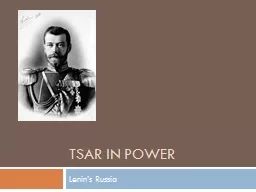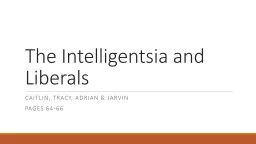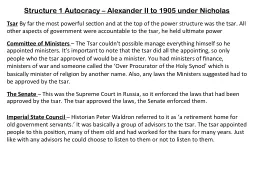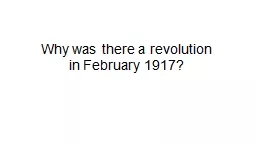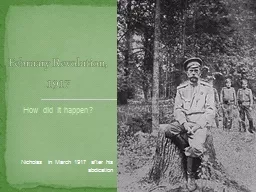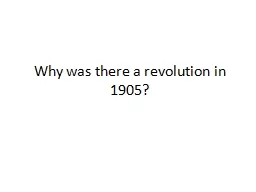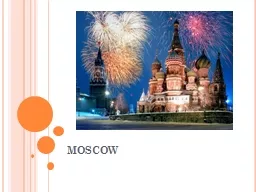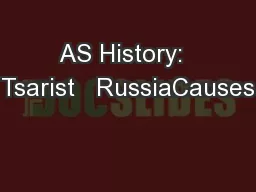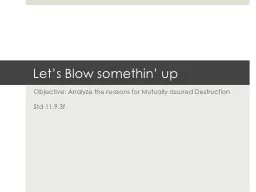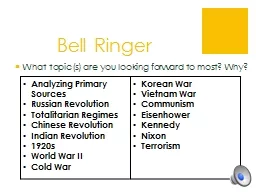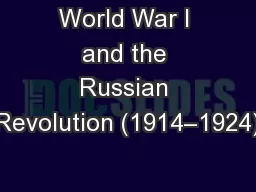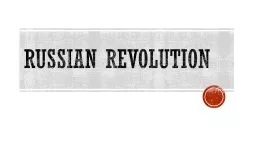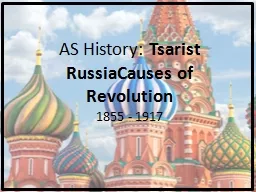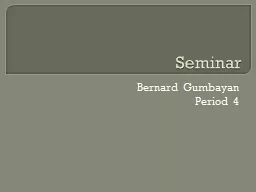PPT-Tsar in power
Author : debby-jeon | Published Date : 2016-06-05
Lenins Russia TsarBackground At the start of the 20th Century 1900 Nicholas II was the Tsar and the ruler of Russia Nicholas was an Autocrat This meant that he had
Presentation Embed Code
Download Presentation
Download Presentation The PPT/PDF document "Tsar in power" is the property of its rightful owner. Permission is granted to download and print the materials on this website for personal, non-commercial use only, and to display it on your personal computer provided you do not modify the materials and that you retain all copyright notices contained in the materials. By downloading content from our website, you accept the terms of this agreement.
Tsar in power: Transcript
Lenins Russia TsarBackground At the start of the 20th Century 1900 Nicholas II was the Tsar and the ruler of Russia Nicholas was an Autocrat This meant that he had complete an absolute power He was not elected but was born into power He and most other Russians believed that he had a divine right to rule that he had been chosen by God . World War I was initially greeted with enthusiasm in Russia. Tsar Nicholas was dominated by his wife, Alexandria. She was born in Germany but raised in England. she hated democratic government. their son was a hemophiliac and could only be helped by a travelling preacher named . Caitlin, Tracy, Adrian & Jarvin. Pages 64-66. Aims. To reform the autocracy so that the tsar would listen directly to his people. To promote welfare, education, liberty and the rule of law. They opposed tsarist oppression and the injustice of the legal system. Tsar. By far the most powerful section and at the top of the power structure was the . t. sar. All other aspects of government were accountable to the tsar, he held ultimate power. Committee of Ministers . 1914. Tsar Nicholas II is in charge . Duma. in place – Elected by rich and Tsar in full control. 1917. Tsar forced from power. Duma. takes full control. Why does this happen? Three areas :. Mistakes of the Tsar. February Revolution, 1917. Nicholas in March 1917 after his abdication. In January 1917 the Tsar received 3 warnings about the negative atmosphere in Petrograd:. Okhrana. state the people hate the war, shortages, and are highly critical of the govt. In comparison to 1917, ‘1905 was but a toy’. Introduction. Context – Tsars had ruled through a strict autocracy for hundreds of years. The use of oppression had kept the public from being able to revolt. In 1905, there was an attempted revolution.. Moscow Metro. Elegant and impressive, full of passion and style . Many of Moscow's metro stations are architectural masterpieces, heavily themed-up with sculptures and mosaics. Moscow Metro. The Moscow Metro not only looks good - it really works efficiently too. . of Revolution. 1855 - 1917. Why was Russia Backwards?. Political. Autocracy. No opposition/ other political parties. Nobles in control. Secret police. Conscripted Army. Economic. Harsh winter – affected farming. Objective: Analyze the reasons for Mutually assured Destruction. Std 11.9.3f. Stronger weapons. Always looking for a way to stay on top. 1942 . idea of more destructive bomb than A-bomb. H-Bomb 67 times more destructive . Analyzing Primary. Sources. Russian Revolution. Totalitarian Regimes. Chinese Revolution. Indian. Revolution. 1920s. World War II. Cold War. Korean War. Vietnam War. Communism. Eisenhower. Kennedy. . Lesson 4 . Revolution in Russia . Learning Objectives. Explain the causes of the February (March) Revolution.. Describe the goals of Lenin and the Bolsheviks in the October Revolution.. Summarize the outcome of the civil war in Russia.. What happened?. What was the Tsar’s response?. Impact of WWI. For Russia, WWI devastating. Nicholas II distrusted the Duma and resisted popular involvement in government . Complete control over the bureaucracy and army. of Revolution. 1855 - 1917. Why was Russia Backwards?. Political. Autocracy. No opposition/ other political parties. Nobles in control. Secret police. Conscripted Army. Economic. Harsh winter – affected farming. Seminar Bernard Gumbayan Period 4 Question Describe and analyze the long-term social and economic trends in the period 1860-1917 that prepared the ground for revolution in Russia. The Great Reforms In 1861, the serfs were freed and received on average about half of the land. Yet they had to pay fairly high prices for their land, and because the land was owned collectively, each peasant village was jointly responsible for the payments of all the families in the village.
Download Document
Here is the link to download the presentation.
"Tsar in power"The content belongs to its owner. You may download and print it for personal use, without modification, and keep all copyright notices. By downloading, you agree to these terms.
Related Documents

